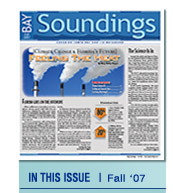 |
||||||||
New Report Documents Aquifer Contamination
The impact of increased populations near public water-supply wells in the northern Tampa Bay region is showing up in the Upper Floridan aquifer, according to a new report from the U.S. Geological Survey (USGS).
“We are seeing the effect of human activity and land-use practices on our ground-water supplies,” said Patricia Metz, USGS hydrologist and lead author on the report. “Although concentrations are very low, their presence indicates the relatively rapid mobility of these contaminants to the ground-water system and the vulnerability of ground-water supplies to contamination from human activities.”
In the first phase of the study, water from 30 wells was analyzed for the presence of 258 compounds generated by humans such as pesticides and volatile organic compounds (VOCs). The samples generally contained an average of four compounds and 70% of the samples had at least one compound. The relative level of contamination was closely linked to land-use type. For example urban areas showed widespread occurrence of pesticides commonly used around the home and gardens, golf courses and public road rights-of-way.
In the second phase of the study, water from the most-contaminated wells was re-sampled after treatment. The pesticide most frequently found was atrazine, a widely used herbicide and likely carcinogen at high levels or with long-term exposure. All wells sampled were at very low concentrations.
In unconfined areas where the aquifer is closest to the surface and most vulnerable to contamination, concentrations were almost double the rate as those in water from wells drawing from confined aquifers protected by relatively impermeable layers of rock. The study also documented the relationship between human population and the number of contaminants detected. Where development was limited, few man-made compounds were detected.
“For the past several decades, we’ve seen land-use changes that may affect the future of our potable ground-water supplies,” Metz said.
Other key findings include:
- Chloroform, a byproduct of disinfectants, was found in 43% of samples. Most frequently detected in residential areas, it may be associated with lawn irrigation, leaking of supply lines, pools and spas.
- The herbicide atrazine and its byproducts (deethyatrazine; 2-hydroatrazine, and deisopropylatrazine) were the most commonly detected pesticides, found in 54% of samples.
- DEET was detected in five samples (17%), most commonly when sampled wells were near septic systems.
- Wells sampled in well fields such as Cross Bar, Cypress Creek, Eldridge Wilde, and Cosme where development is limited contained few or no human-generated compounds.

